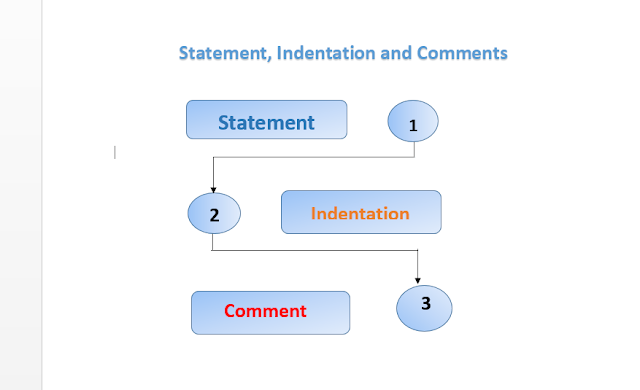Statement, Indentation and Comment in Python
Statement :
The written instructions in the source code
by which the interpreter can read and execute. There are different types of
statements are available for example, ‘i=2’ is an assign statement, ‘for in
range’ is a looping statement, ‘while’ is an conditional statement and more.
Multi-line statement :
Statements in Python can be extended to
one or more lines using parentheses (), braces {}, square brackets [], semi-colon
(;), continuation character slash (\). When the programmer needs to do long
calculations and cannot fit his statements into one line, one can make use of
these characters so the calculations can be continued.
Example :
Declared using Continuation Character (\):
s = 1 + 2 + 4 + \
4 + 5 + 8 + \
7 + 8 + 5
Declared using parentheses () :
n = (1 * 2 * 3 + 6 + 8 + 9)
Declared using square brackets [] :
footballer = ['MESSI',
'RONALDO',
'SUAREZ']
Declared using braces {} :
x = {3 + 2 + 3 + 9 + 5 + 6 +
7 + 8 + 4}
Declared using semicolons(;) :
flag = 1; ropes = 8; pole = 9;
Indentation :
A block is a combination of all these statements. Block can be regarded
as the grouping of statements for a specific purpose. In most of the
programming languages like C, C++, Java use braces { } to define a block of
code. One of the distinctive features of Python is its use of indentation to
highlight the blocks of code. Whitespace is used for indentation in Python. All
statements with the same distance to the right belong to the same block of
code. If a block has to be more deeply nested, it is simply indented further to
the right. You can understand it better by looking at the following lines of
code as an example:
# python program showing indentation
site = 'cd'
if site == 'cd':
print('Logging
on to codedudle...')
else:
print('retype
the URL.')
print('All set !')
Output :
Logging on to codedudle...
All set !
The lines print(‘Logging on to codedudle…’) and
print(‘retype the URL.’) are two separate code blocks. The two blocks of code
in our example if-statement are both indented four spaces, in code. The final
print(‘All set !’) is not indented, and so it does not belong to the
else-block.
j = 1
while(j<= 6):
print(j)
j = j + 1
Output:
1
2
3
4
5
6
To indicate a block of code in Python, you must indent
each line of the block by the same whitespace then it will be considered. The
two lines of code in the while loop are both indented four spaces. It is
required for indicating what block of code a statement belongs to. For example,
j=1 and while(j<=6): is not indented, and so it is not within while block.
So, Python code structures by indentation.
Comments :
This is the simple
thing clearing by its name, we use comments to clearify the confusing to the
developer. We use (#) to give a comment.
Example :
Code 1:
# This is a comment
#printing the “codedudle”
Print(“codedudle”)
Code 2:
a, b =
1, 3 # Declaring two integers
sum = a
+ b # adding two integers
print(sum)
# displaying the output
Multi-line string as comment :
Python multi-line comment is a piece of text
enclosed in a delimiter (""") on each end of the
comment by the help of this you can write comment as many as you want, Again
there should be no white space between delimiter ("""). They are useful when the
comment text does not fit into one line; therefore needs to span across
lines. Multi-line comments or paragraphs serve as documentation for others
reading your code. See the following code snippet demonstrating multi-line
comment:
Code 1:
|
In this article i have briefly discussed about statement, indentation and comments in python.
Next article : Decision Making
#python
#django
#pycharm
#anaconda python
#opencv
#matplotlib
#python online
#python programming
#python list
#learn python
#python requests
#introduction to data science in python
#free python tutorial
#learn python basics
#python study
#python and ai
#python computer science
#learn python step by step
#best course to learn python
#learn python with projects
#python artificial intelligence tutorial
#micropython
#python for data science
#data science from scratch
#micropython esp32
#machine learning using python
#matplotlib
#python 3
#scikit learn
#learn python for data analysis free









0 Comments
If you have any doubt, Please let me know.